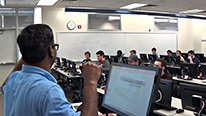- Fabio Milner
- http://math.asu.edu/~milner
- Professor and Director of Mathematics for STEM Education
- Developing & Investigating Rigorous Approach to Conceptual Calculus
- http://patthompson.net/ThompsonCalc/
- Arizona State University ASU
- Hedvig Mohacsy
- https://math.asu.edu/node/930
- Lecturer
- Developing & Investigating Rigorous Approach to Conceptual Calculus
- http://patthompson.net/ThompsonCalc/
- Arizona State University ASU
- Pat Thompson
- http://pat-thompson.net
- Prof.
- Developing & Investigating Rigorous Approach to Conceptual Calculus
- http://patthompson.net/ThompsonCalc/
- Arizona State University ASU
Public Discussion
Continue the discussion of this presentation on the Multiplex. Go to Multiplex









Fabio Milner
Professor and Director of Mathematics for STEM Education
The DIRACC (Developing and Investigating a Rigorous Approachmto Conceptual Calculus) team has worked for the past 4 years in the development of a new curriculum, materials, assessments, and training for faculty and graduate teaching assistants for first and second semesters of calculus for scientists and mathematics majors. The desire to develop a new approach to conceptual calculus arose from two sources: a desire that students learn calculus meaningfully and coherently and past research that revealed calculus students’ misunderstandings and faulty meanings both before and after studying calculus.
DIRACC calculus frames the entirety of calculus in one variable with two foundational problems:
The experience of DIRACC at Arizona State University produced significant results, both in terms of gains measured by pre- and post-tests and performance in "downstream" reasoning courses such as multivariate calculus and the first proof course.
We invite you to get a taste of DIRACC calculus at http://patthompson.net/ThompsonCalc/. We hope you see potential value, whether you are a student trying to understand the main concepts of single-variable calculus or a teacher trying to help your students do that.
Becca Schillaci
Research Associate
Hi Fabio. It's sounds like DIRACC Calculus is showing promise. What do you think are some of the course features that contribute to it's success with students?
Fabio Milner
Professor and Director of Mathematics for STEM Education
Hi, Becca. One of the main contributors is laying responsibility on the students for expressing correctly what they are thinking. They need to do that both orally and in writing. They use the computer program Graphing Calculator and quickly discover that, in order that the program do what they want it to do, they need to "tell" it in writing, accurately and unequivocally what that is.
Becca Schillaci
Gregory Rushton
Director, TN STEM Education Center
Hi, thanks for sharing your work with us....I'm not clear on how studying the accumulation function helps students get to a fundamental understanding of calculus better than traditional approaches...can you say more about the connection between these two ideas theoretically? thanks again!
Hedvig Mohacsy
Lecturer
Hello Gregory,
Studying the accumulation function helps students answer to the question "You know how fast a quantity varies at every moment; you want to know how much of it there is at every moment."
Recreating a linear function from an initial value and from the constant rate is an easy task for a calculus students. Can we recreate any differentiable function from an initial value and from the rate of change function as well?
Yes, it is quite simple. Every differential function, locally is essentially linear. Thus, we can compute dy=mdx many times and adding the bits of changes together to find the value of the function. The accumulation function, beyond its own mathematical beauty, gives the meaning of integration and can be applied in real life scenarios, instead of introducing integrals as a tool to calculate areas, volumes etc.
As we constructed the accumulation function in class and understood the meaning of it, the Fundamental Theorem of Calculus was proved effortlessly and elegantly. The structure of the course made us see the big picture after few weeks, only using simple concepts such as constant rate of change and linearity.
In the online book, in chapter 5, you can find application problems: how can we find the the high of the rocket from the its velocity; what is the volume of the oil leaked, if we know the rate at which the volume of the oil changes with respect to time. http://patthompson.net/ThompsonCalc/section_5_1.html
Patrick Thompson
Hi Gregory,
I'll add to Fabio's reply.
Accumulation from rate of change is easier for students to conceptualize than is rate of change from accumulation. Studying accumulation functions first also makes the idea of deriving rate of change functions more natural: If you take any function that gives an amount of a quantity, you can re-conceive it as each value of that quantity as having accumulated. But if it accumulated, it accumulated at some rate and therefore must be of the form f(x)=int(a,x,r(t)dt). The problem then becomes recovering r(x) from f(x).
Another reason DIRACC develops accumulation functions first is that, using the graphing program Graphing Calculator, students can define accumulation functions in open form and they become "first-class" functions. Students can evaluate them, graph them, or anything they could do with a function defined in closed form.
As Fabio points out, chapters 4 and 5 lay this out in detail.
Yours,
-Pat
Monae Verbeke
Senior Research Associate
After watching this, I'm wondering what you how student's take to other areas of their studies/lives and if you've tried to study this transfer?
Patrick Thompson
Hello, Monae.
We haven't studied this question yet, but it will be important to do so.
Yours,
Pat Thompson
Amy Hackenberg
Thanks for the video about this important project. I wonder what you might be doing next to spread the impact... for example, is there professional development in the works about this approach so that instructors/professors outside of ASU might get involved?
Further posting is closed as the showcase has ended.